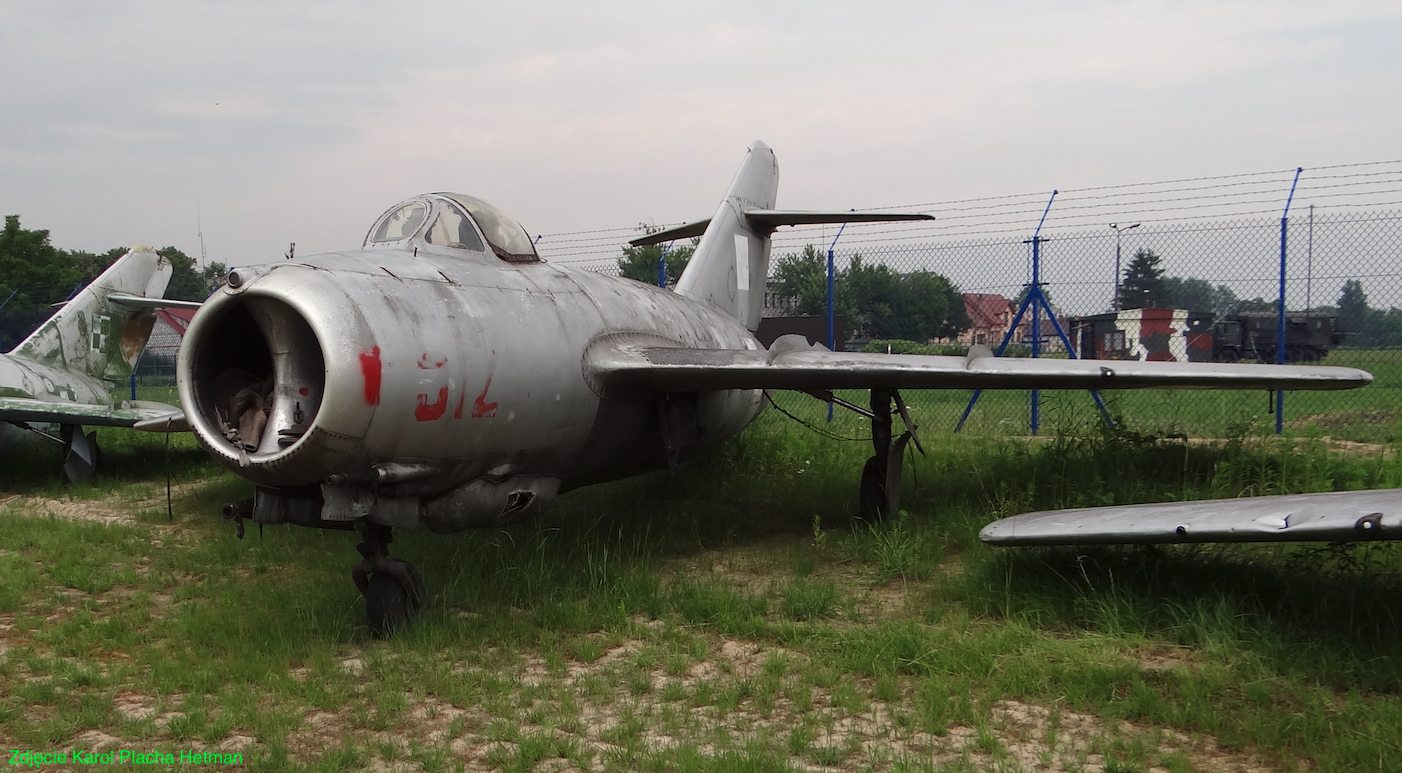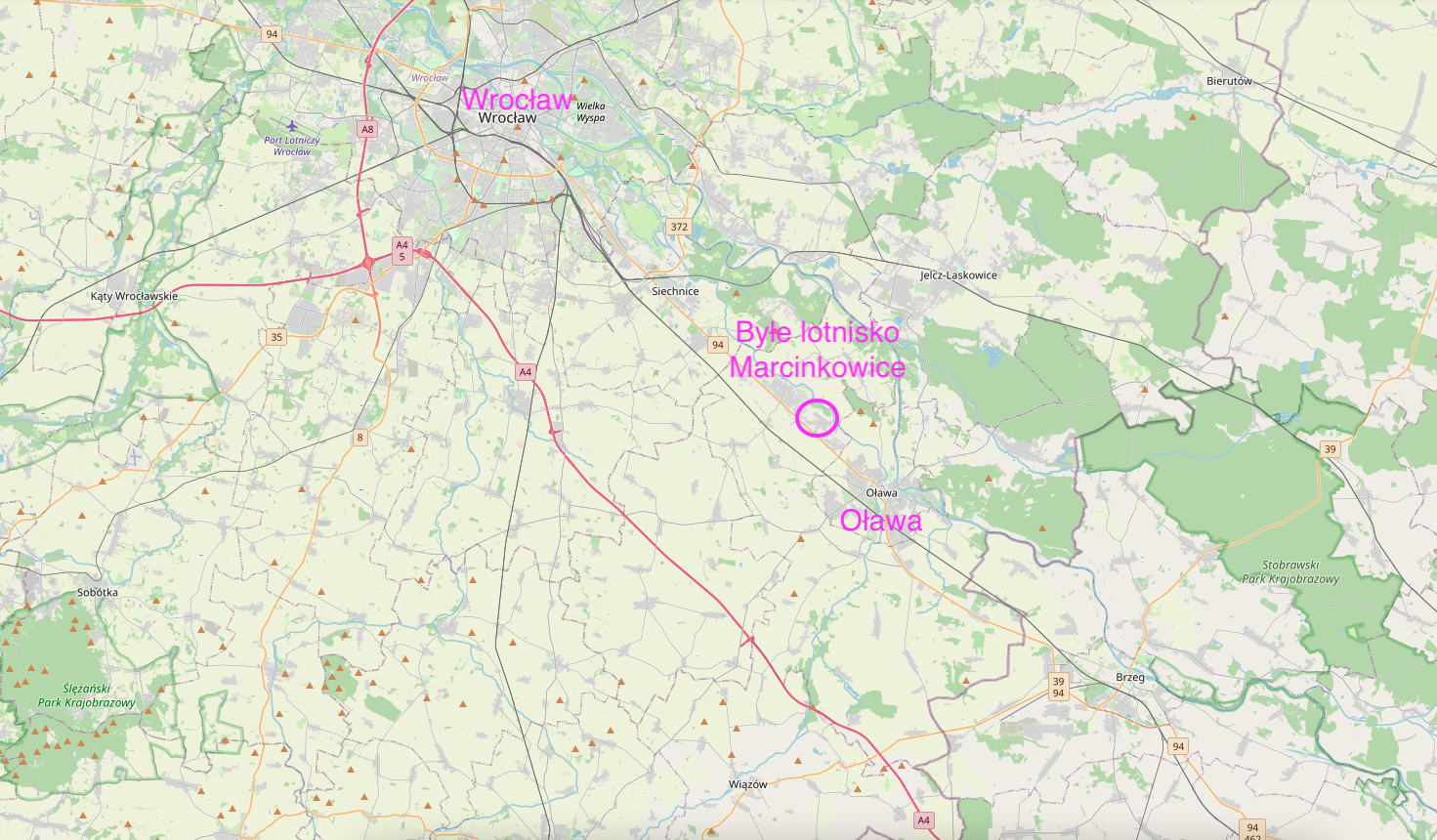Oława 2023-03-22
Marcinkowice Airport near Oława.
Geographic coordinates: 50.975N 17.253E. Elevation 128 m.



The Treaty of Versailles, which ended the bloody Great World War, forbade the Germans to have military aviation. The problem was that the victorious countries were unable to enforce the Treaty of Versailles. In 1933, in Germany, Hitler was legally elected chancellor, the future world thug. On February 26, 1935, Hitler signed a decree establishing the Air Force (Luftwaffe) as the third independent branch of the German armed forces. In the eastern part of Germania, numerous military airports were built, which were used for aggression against the Republic of Poland.
The former Marcinkowice airport near Oława was founded in Germanic times in the second half of the 1930s. The Germans, building this airport, gave it the codename "Kopernikus", stealing the name of the great Polish astronomer and having numerous other qualities - Nicolaus Copernicus.
Marcinkowice was well suited for the airport. The land was flat and large. The geological drillings confirmed that the ground was compact, on a sandy foundation. In 1937, compensation was paid to the owners and land was offered in other towns. Few buildings were razed to the ground, and only a brick manor house was left.
The airport was built along the Wrocław - Oława road and railway route. Currently, it is the national road No. 94 and the railway line No. 132 Wrocław - Bytom. A siding was built from the railway route to the airport. In this way, the airport gained good communication with Wrocław. The Oława River flows near the airport. There is no mention of the ceremonial opening of the airport in the documents, which means that in September 1939, the airport was not completed.
Airport infrastructure was poor. Two large hangars and numerous wooden barracks were built, which served as barracks, headquarters, warehouses, workshops, canteens, canteens, lecture halls, and common rooms. A fuel, lubricant and ammunition depot was established. The landing field was dirt. In August 1939, three squadrons arrived at the airport in Marcinkowice with Messerschmitt Bf-110 C planes (33 copies) and Heinkel He-111 bombers (35 bombers).
On September 1, 1939, the Germanic army invaded Poland, together with the CCCP, and carried out the fourth partition of the Republic of Poland. But the Polish nation fought bravely against both occupiers. From Marcinkowice and other airports, planes started bombing Polish cities. It is known that on September 2, 1939, three Heinkel He-111 bombers did not return to the airport from combat flights, which were shot down by Polish fighters from the 161st and 162nd Fighter Squadrons.
At the beginning of 1945, Soviet Il-2 and Yak-1 planes were based at the airport; which attacked the fortress of Wrocław, which the Muscovites did not capture until the end of the war. After the war, the Marcinkowice airport was occupied by the Soviet army and incorporated into the 4th Air Force and served as a backup airport. In 1949, the political situation in Europe was bad. Muscovites blockaded West Berlin, and a moment later joined the war in Korea. As a result of these events, another fighter aviation regiment was based at the Marcinkowice airport, which was equipped with MiG-15 aircraft. For this reason, the landing field was reinforced with a steel mesh. At that time, the airport received the codename "СКАЛЬП" - "Skalp".
Ground take-off field reinforced with metal mesh.
In 1944, the Soviets came across the strengthening of the ground take-off field with a steel mesh. The Americans wanted to increase aid for the Home Army. More armament could be delivered if the payloads of the planes were to be used, but the planes should be able to refuel. That is why the idea arose that after dropping the cargo on parachutes for the Home Army units, the planes would land and be refueled for the return journey. The airport in Radawiec near Lublin was selected, which at that time was already in Soviet hands. Stalin gave his consent, which he later withdrew. But the Americans had already delivered steel nets to the airport. Of course, the Muscovites did not give them away. Years later, Muscovites set up such nets at Marcinkowice near Oława, Gola near Gostynin and other airports. Reinforcement of the take-off field with nets is also used today. Among other things, at the airport of the Aeroclub of Włocławek - Kruszyn airport.
The runway in Marcinkowice had dimensions of 2,500 m x 60 m, and was located in the direction 13/31.
At the beginning of the 1960s, a Soviet fighter unit was transferred to the airfield in Brzeg, where a large concrete runway was built. Marcinkowice Airport began to function as a backup airport. Helicopters flew here more often than fighter planes. The lack of financial resources did not allow Muscovites to expand the airport. The concrete RWY was never built. Besides, the airport was far from the Baltic Sea and the western border of Poland.
The Soviets left the Marcinkowice airport on August 15, 1992. The airport was handed over to the Polish Army to remove any unexploded ordnances, chemicals and petroleum substances. After these activities, the airport was handed over to the commune. Since the area of the former Soviet airport did not require the preservation of an aviation character, it was decided to allocate the area to industrial areas. In 1997, Poland was hit by a big reason, which is why part of the former airport was allocated for single-family housing. Initially, 25 houses were built. Currently (2023) the following plants have been funded at the former airport: The Lorenz Bahlsen, FIEGE LOGISTICS, ZPRE, Wastewater Treatment Plant, ARMETON, ROBA METALS, Semmelrock Stein, ARDEX, O2A, ZIAJA, KOMPOZYTY, Brama Europa, Aleuro Converting, CNC Jurczak, Azpiaran, PACKER. There is no trace of the German-Soviet airport.
It is 7 km from Marcinkowice to Oława, 19 km to Wrocław and 22 km to Brzeg. In 2021, the population of Marcinkowice was 2,133 people. The most important monument in the village is the Church of St. Marcin Biskup. It is the fourth temple on this site, which was built in 1932. The area of the former airport also belongs to the commune of Stanowice.
Written by Karol Placha Hetman
